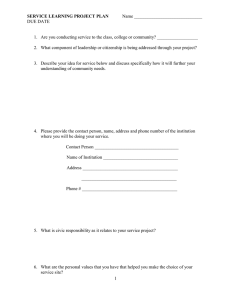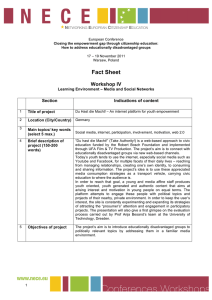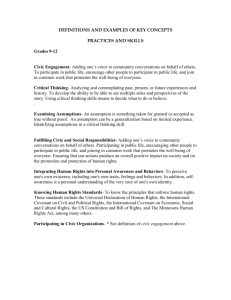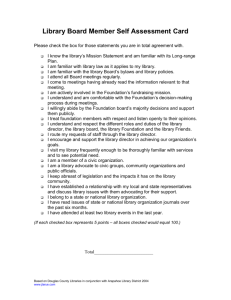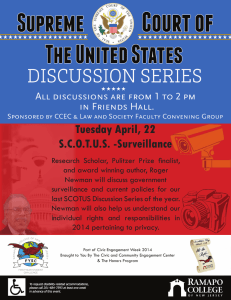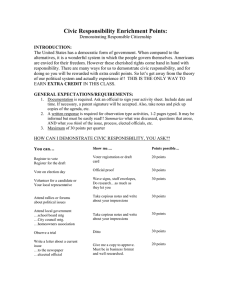Closing the empowerment gap through citizenship education
advertisement
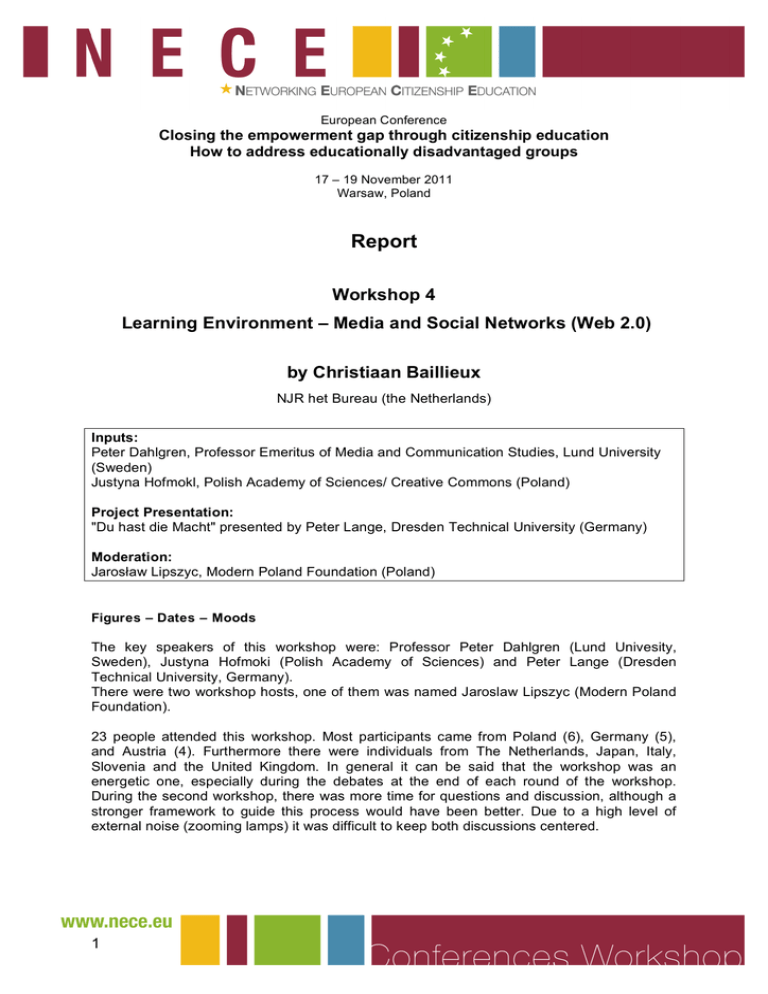
European Conference Closing the empowerment gap through citizenship education How to address educationally disadvantaged groups 17 – 19 November 2011 Warsaw, Poland Report Workshop 4 Learning Environment – Media and Social Networks (Web 2.0) by Christiaan Baillieux NJR het Bureau (the Netherlands) Inputs: Peter Dahlgren, Professor Emeritus of Media and Communication Studies, Lund University (Sweden) Justyna Hofmokl, Polish Academy of Sciences/ Creative Commons (Poland) Project Presentation: "Du hast die Macht" presented by Peter Lange, Dresden Technical University (Germany) Moderation: Jarosław Lipszyc, Modern Poland Foundation (Poland) Figures – Dates – Moods The key speakers of this workshop were: Professor Peter Dahlgren (Lund Univesity, Sweden), Justyna Hofmoki (Polish Academy of Sciences) and Peter Lange (Dresden Technical University, Germany). There were two workshop hosts, one of them was named Jaroslaw Lipszyc (Modern Poland Foundation). 23 people attended this workshop. Most participants came from Poland (6), Germany (5), and Austria (4). Furthermore there were individuals from The Netherlands, Japan, Italy, Slovenia and the United Kingdom. In general it can be said that the workshop was an energetic one, especially during the debates at the end of each round of the workshop. During the second workshop, there was more time for questions and discussion, although a stronger framework to guide this process would have been better. Due to a high level of external noise (zooming lamps) it was difficult to keep both discussions centered. 1 Mood, debating atmosphere and procedural feedback: In the first round the moderator used orange cards on which several pros and cons on the use of social media as an instrument for participation were formulated. By placing the cards on the floor and shifting them around, the group was able to establish which pros and cons were most significant. The second moderator used several statements and questions to stimulate the debate after the presentations were finished. The downside of having two moderators is that the second moderator does not bring the experience from the first session in to the second. Content and Inputs Professor Peter Dahlgren from the department of Communication and Media of the Lund University commenced this workshop with a presentation on the use of Internet by young people today. He stated that the web has become central to their lives, not only to socialize but also to be part of a discussion, which contributes to the democracy of today. The web, Internet, or web 2.0, offers great opportunities to strengthen democracy, in a time when there is a lack of civic participation all over Europe. To understand what can promote or hinder civic participation, Dahlgren describes civic cultures consisting of 6 interdependent dimensions. Civic cultures are used by people to create their own identity to participate as citizens. These cultures are historically shaped over time. Peter Dahlgren describes knowledge, values, trust, space, practices/ skills and identity as interdependent dimensions that affect participation in terms of web 2.0. Next to this he explains that civic participation consists of communication, which of as today has everything to do with ‘being connected’. People can function without access to Internet, but they become handicapped. This digital divide, he states, is a barrier to democratization. However, access and great knowledge of web 2.0 will not ‘fix’ democracy. Social networks, for example are flexible and very individualistic (self marketing). They therefore embody all good and negative interactive aspects of people. Although there is enough room on the net, this in itself might be an obstacle to use it for the empowerment of democracy. The second speaker was Justyna Hofmokl. She is a sociologist specialized in understanding social influences of new technologies, as well as of new modes of production and the sharing of cultural goods. Justyna started her story with elaborating on the importance of the net today in comparison to former decades when Internet was only available to a minority. Ms Hofmokl illustrated this with an example about a youngster, Thomas Suarez, which makes a fortune on the Internet by selling ‘aps’ trough Apple’s aps store. After a while, Thomas, started to teach his peers to become programmers as well. A second example is Mr Khan, a former banker. Trough the net he gave small lectures on mathematics by making online clips. Apart from his family, other people also began to benefit from his online lectures especially because had such great skills in teaching. This one-man project show’s great opportunities of the net, also for low-income countries such as India. (http://www.khanacademy.org/) Most importantly, both examples are based on existing instruments that can be found and used on the Internet today. Based on these examples Justyna concludes that lack of access to the Internet is no longer the problem. 2 In Poland for example, 2/3 of the youth have access to Internet on a daily basis. She stated that activity on the Internet is also contributing to a more active life in general. However, there is also a group within society, which is (still) digitally excluded. This group - mostly older and less educated people - experience the Internet as useless, time-consuming and complicated to learn and use. Research has found that this group does not make the effort to learn how to use the Internet. The question is how we can overcome this divide? According to Justyna, this can be answered by focusing on the accessibility (language) and content of the Internet. Besides this, we have to convince the digitally excluded group that Internet is a very useful tool. They have to experience the possibilities by means of relevant and accessible information, which then becomes a reason to continue to use the Internet. Project Presentation The third speaker was Peter Lange. Peter is currently studying at the Dresden Technical University. He is also part of a project team which evaluates the website project ‘Du hast die Macht’ (http://www.duhastdiemacht.de). ‘Du hast die Macht’ is a web-based approach to civic education, which aims to connect with educationally disadvantaged groups. The content is bases on the following themes; protest, power, future, culture and opinion. Photo, video and short texting articles are used to inform and involve young people on several topics. The tone is very important for all types of content. It should be accessible for young people. Social media such as Facebook and YouTube are used to extend and reach even more users. The key strategy is to use the net as a vehicle, carrying civic education to where the audience is. ‘Du has die Macht’ attempts to engage young people on political topics and project that are close to their private environment. This experimental project has undergone several changes. For example, the renewed website has a great deal more graphics and new features, such as a map were you can find participatory project in your neighborhood. The evaluation of this platform (website), which is executed by Dresden Technical University, shows three dilemma. First of all, the content of the website is either too complicated or too simple. Second, what is the concept of politics? When you ask young people to describe politics, they often refer to government buildings. However, one must address this topic in order to expand their perspective. The third dilemma is how to address young people. Which tone is suitable to attract and connect young people? Insights from the discussion All three presentations showed great opportunities to reach social disadvantaged groups through Internet and social media. After two more theoretical elaborations, a practical example provided greater understanding of Internet and social media as a vehicle for civic education or participation. After the presentations, the moderator used the orange cards to make an inventory on pro’s en con’s regarding application of the net of social media for civic education or participation. The most important outcome was that the group agreed on the fact that the Internet is cheap and accessible, and that it offers new outreach of possibilities. However, the biggest barrier is the oversimplification of complex issues (societal, political), especially towards young people. This causes the online debate to become superficial and lacking context. Moreover, discussions or dialogues are hard to structure and become fragmented. Apart from privacy issues, the group suggest that social media is collective but not public. Therefore transparency is not insured. 3 Regarding the presentation of Professor Peter Dahlgren, the second group debated whether access to the Internet in itself is enough for civic purposes. Internet is still predominantly dominated by sex and advertisements, so why should people use it to talk about politics? Participants also had questions about the cost of ‘Du hast die Macht’. It is a very expansive platform, and one may ask whether the goal justifies the means. Moreover, what is the extra value of developing another website, whilst young people spend most of their time on Facebook? Would it not be better to use existing interfaces for the same purposes? In the end people seem to agree that online activities will not replace activities in real life. It can be interesting to use social media as a vehicle for participation alongside real activities. In the end, use of the Internet will strengthen the participation process instead of being a solution. Since almost everybody is connected, thinking about the divide has to be updated and applied to different geographical locations. As stated in the presentations, it is not a question of accessibility but rather of the way we use the Internet. There were no real conclusions given as to how we can improve the way we use the internet, except the fact that internet usage alone will not increase civic education. Furthermore, there needs to be more research done to establish who the educationally disadvantaged groups are, and which strategy can be used to approach these specific group. These questions need to be explored in order to continue working on this topic. 4
